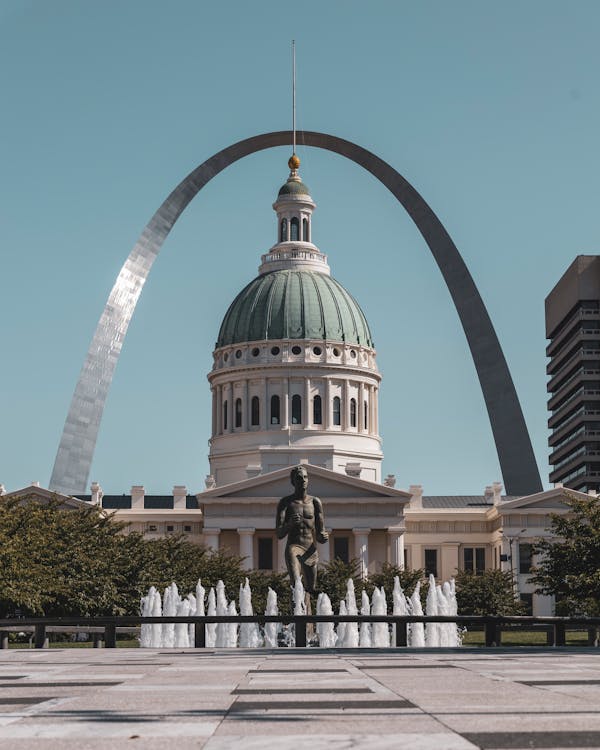A Timeline History of St. Louis
St. Louis was connected to the rest the country via railroads after the mid-century mark. In 1851, the Pacific Railroad Company started west building and by 1863, St. Louis was connected to the east coast via railroads. Rapidly, rail traffic replaced river traffic. In 1874, the Eads Bridge was inaugurated and carried rail traffic across Mississippi. When it opened in 1894 St. Louis Union Station was the world's largest single-level passenger rail terminal.
After the failed revolutions in 1848, German immigration increased dramatically to the United States. St. Louis soon had a significant German population. The Civil War saw the Union retaining St. Louis and Missouri thanks to the abolitionist sentiments of ethnic Germans. Although no major battles were held in St. Louis during the Civil War, the city played an important role by providing military supplies and care for the wounded and sick.
A group of St. Louisans founded the Missouri Historical Society in 1866 immediately following the war. Their Missouri History Museum in Forest Park now displays the history of St. Louis, Missouri. In 1870, the Alexian Brothers Hospital, which is now part of St. Alexius Hospital received its first patients. The St. Louis Art Museum was established in 1879 by the St. Louis School of Fine Arts and Museum of Fine Arts. It is an independent entity of Washington University. The original location of the museum was downtown. It was later moved to Forest Park.
The industrial expansion continued into the 20th century. The St. Louis World's Fair was better known as the Louisiana Purchase Exposition of 1904. The Barnes Hospital, which is now part of Barnes-Jewish Hospital was opened in 1912. The bequest of Robert Barnes, a St. Louis banker who gave Adolphus Busch a $50,000 line credit to finance his brewery business, had funded it. Charles A. Lindbergh made his solo transatlantic flight in 1927 with the support of a group of St. Louis businessmen. He named his craft Spirit of St. Louis to acknowledge their support. The City Art Museum is known for its Corinthian columns, and the Louis IX (St. Louis), statue that stands in front. It is situated in Forest Park on 1400-acres, which includes the Jefferson Memorial, Planetarium and the St. Louis Zoo. The International Bowling Museum and Hall of Fame is a more specialized museum.
The city of St. Louis contains the city of St. Louis. It is located on the west bank the Mississippi River, just below its confluence to the Missouri. The French director-general of Louisiana granted the exclusive rights to Maxent, Laclede and Company to trade with Indians in 1763. The grant covered the Missouri River and Mississippi, from Illinois to Minnesota.
Pierre Laclede led a group that set out to create a trading post. They established themselves first at Fort Chartres on the east bank of the river. Laclede explored the west bank of the river during winter, and found that it would be best to locate the settlement somewhere slightly below the Missouri. A party of 30 arrived at the spot on February 14, 1764 and began building a settlement. Laclede called it St. Louis in honor of Louis XV, who was then the French king, and Louis IX (the current king's patron saint).
The Treaty of Paris of 1763 gave the British French lands east of Mississippi, including Fort Chartres to France. Many French-Canadians and French-Canadians moved to St. Louis from Illinois. The city grew to 600 people by 1772. St. Louis was primarily a French community, even though a Spanish lieutenant governor arrived to establish Spanish control on previously French lands west and south of the Mississippi in 1770. It was briefly returned to France before being sold to America as part of the Louisiana Purchase 1803. *
St. Louis, which was established in 1804, was the seat of government in the District of Louisiana. It also served as the capital of Missouri from 1812-1814. St. Louis was established as a municipality in 1809. It was granted a charter in 1823. It was part St. Louis County up until the 1875 state constitution that separated them. St. Louis Academy opened in 1818. Later, it was taken over by Jesuits and renamed St. Louis University. This was the first university established west of the Mississippi.
The fur trade was the main reason St. Louis's importance for the first forty years of the 19th Century. Although the fur trade declined after 1840, St. Louis had already established itself as a river port. In 1817, the Zebulon M. Pike was the first paddlewheeler to reach St. Louis. The paddle wheelers were the dominant mode of transportation on the Mississippi during the 1830-181860 period, with the peak in dockings being in the 1850s.
Shaw's Garden, also known by the Missouri Botanical Garden (also known as Shaw's Garden), was established in 1858 by Henry Shaw, a St. Louis philanthropist. It was opened to the public in 1859. The Old Courthouse is located near the waterfront. This is where the Dred Scott Case first was tried. Washington University in St. Louis was established as Eliot Seminary, which opened its doors to students in 1853.

